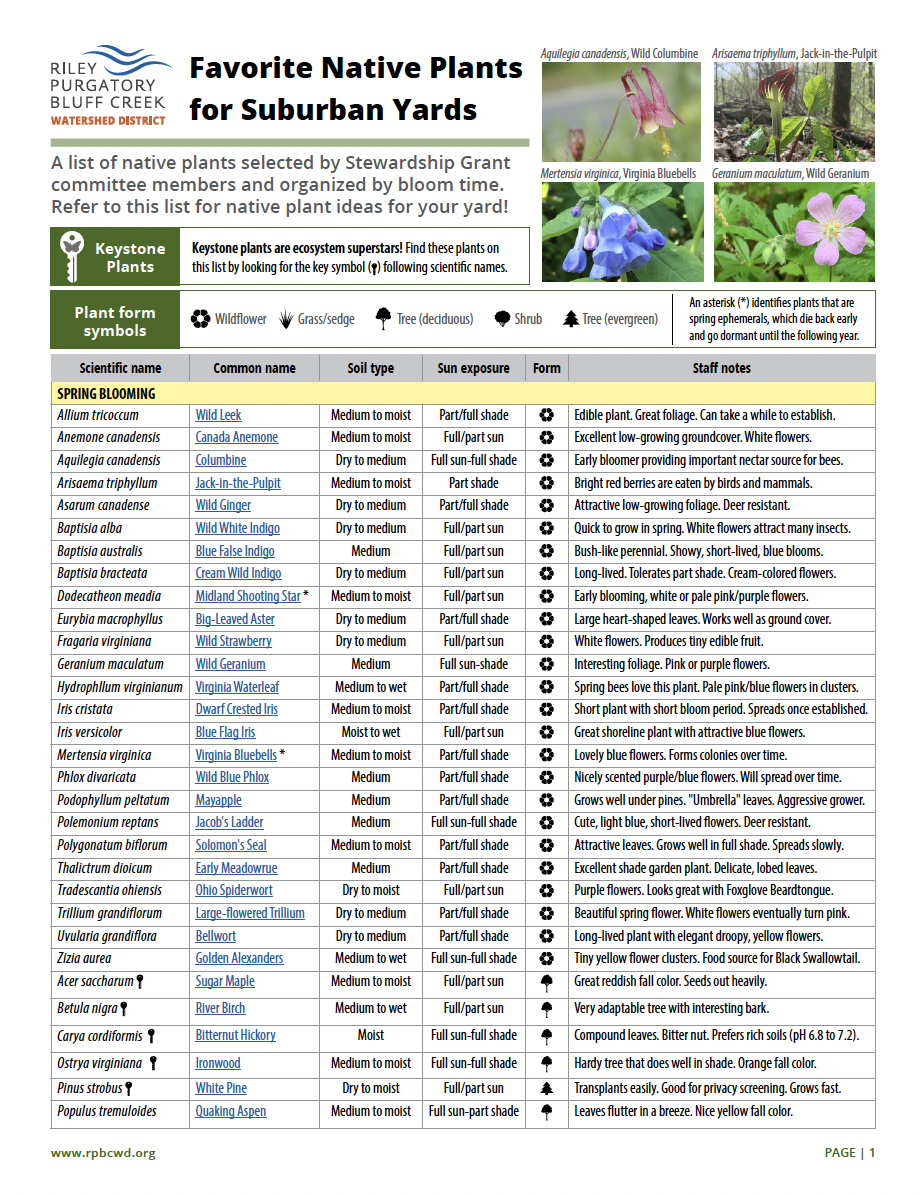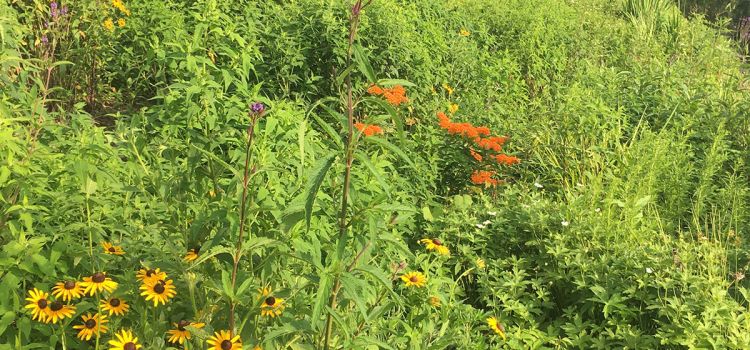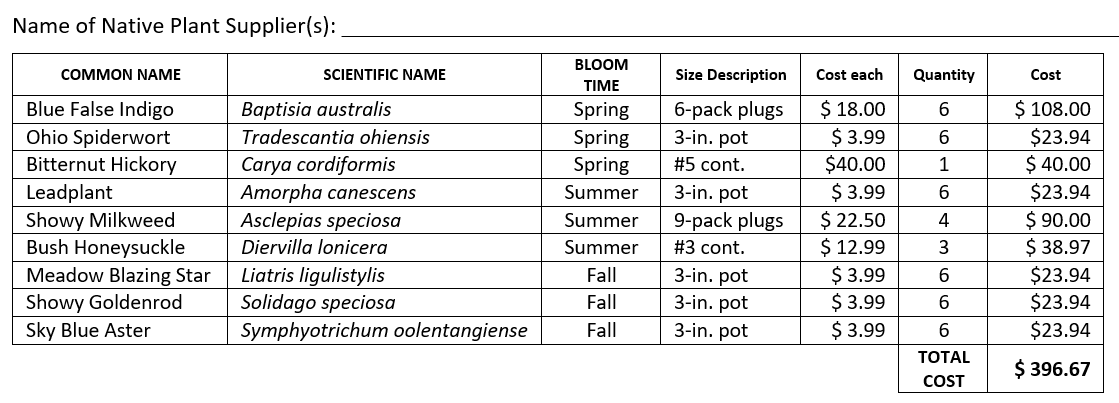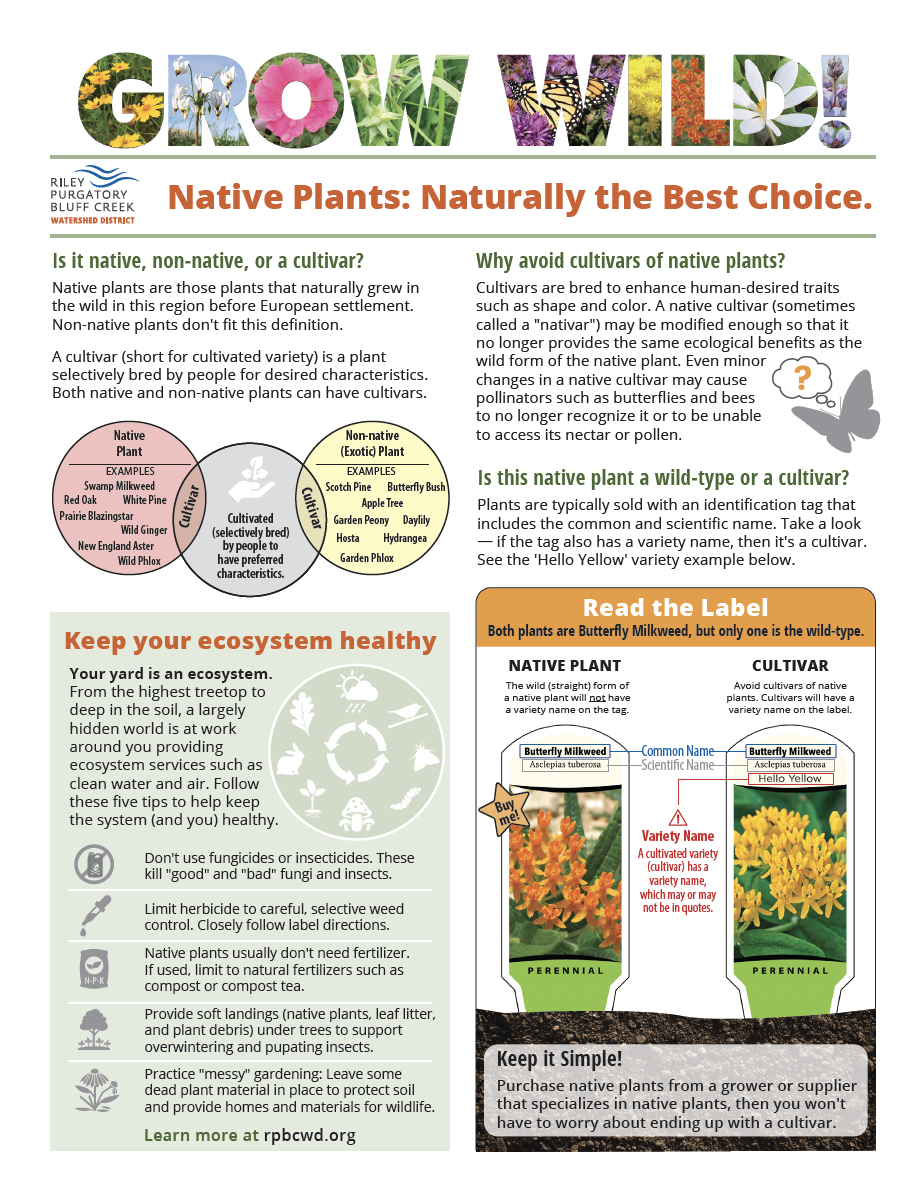Native Plant Requirements
What is a Native Plant?
RPBCWD definition of native plants:
Plants that are native to the region between central Minnesota and central Iowa. Native plants must be in their natural, wild form. Cultivars (cultivated varieties) of native plants are not permitted.
For a list of recommended plants, check out our list of Favorite Native Plants for Suburban Yards.
Visit the Minnesota Wildflowers website, an online field guide to flora of Minnesota, to help determine if a plant is native or not. There are multiple companies in the Twin Cities Metro that specialize in native plants and offer pre-selected combinations of native plants to meet your needs. Check out the resources section at the bottom of this page!
Check out the Native Plants Resources page!

Native Plant Requirements for Cost Share Projects
Some Stewardship Grant projects (native planting, habitat restoration, shoreline restoration, and waterbody buffer) require the use of native plants. These projects must meet the below requirements. We have experts who can help with plant selection!
- Wild form: Native plants must be in their wild form. No cultivars (cultivated varieties) are allowed. Learn tips for selecting native plants in our Grow Wild handout.
- Approved source: Native plants must be purchased from a reliable native plant grower/vendor. See the "Resources" section at the bottom of the Stewardship Grant webpage for a list of potential vendors.
- Appropriate selection: Plant selection must be appropriate for site conditions. In other words, evaluate your site’s sun exposure and soil conditions and pick plants that will do well there. Avoid purchasing plants that have been container-grown for more than a couple of years – these plants are usually less healthy. Smaller plants are also more cost-effective!
- Blooms in each season: Plant selection must include at least 9 different species with 3 species that bloom in spring, 3 that bloom in summer, and 3 that bloom in fall. All flowering plants including trees, shrubs, and grasses count! You can use this list of Favorite Native Plants for Suburban Yards conveniently organized by bloom time.
- Keystone species: Plant selection must include at least one (1) keystone species, which is a plant that supports the wildlife food web (birds, insects, etc.). Your keystone species can be the same as a plant counted toward the "blooms in each season" requirement. See the resources section on the Stewardship Grant webpage for a list of keystone species.
- Ecologically friendly maintenance: You must use ecologically friendly maintenance techniques. This means limiting chemicals and leaving plant material in place. See “Ecologically Friendly Maintenance” below for details.
What Your Native Plant List Should Include
Projects that require native plants (native garden, restoration, and buffer projects) need to provide detailed native plant information. At minimum, the native plant list you submit with your grant application should include the following:
- Native plant source/supplier/vendor - We want to make sure the native plant source you're using is reputable. Check out this list of Minnesota/Wisconsin native plant nurseries and contractors from Wild Ones - Prairie Edge Chapter.
- Scientific plant name - This is the Latin name including genus and species. For example, Asclepias tuberosa is the scientific name for Butterfly Milkweed. However, some people may call it by another common name such as Butterfly Weed or Orange Milkweed, which is why we want the scientific name.
- Quantity proposed for each species - Are you proposing to plant one or six of an individual species? We realize availability of your proposed list may vary, but don't worry -- we'll allow substitutions and quantity adjustments if you ask us.
- Season of bloom - So the habitat value of your project is maximized, we require at least three different blooming species for spring, summer, and fall. Native plant nursery websites, catalogs, or plant labels will include bloom time. You can also look up plants on Minnesota Wildflowers.
Example Native Plant List
Check out these examples to help you plan your project:
- Example of plant list from a grant project (pdf)
- Generic Native Plant List Example (pdf)
- Want a template? Download a native plant list spreadsheet (Excel file) that you can populate with your plant selections (open in Excel, Google Sheets, or other spreadsheet application).

Ecologically Friendly Maintenance
Native plants provide the most benefit when they are given a chance to thrive within a natural, healthy ecosystem.
- Do not use fungicides or insecticides. These kill "good" and "bad" fungi and insects.
- Limit herbicide use to invasive weed control and carefully follow label directions.
- Plan to pull or otherwise control weeds at least three times during the growing season. This reduces competition with native plants.
- Limit fertilizer use to those without harmful salts. Natural fertilizers such as top-dressing with compost or compost tea are preferred. Native plants usually do not need ANY fertilizer. Alternative (bee) lawns: Clover and other legumes fix nitrogen in soil so fertilizer isn't needed.
- Limit watering to the plant establishment phase (usually the first couple of years) or during extended extreme drought.
- Select appropriate weather conditions for proper planting and seeding.
- Provide soft landings (native plants, leaf litter, and plant debris) under trees. Soft landings support overwintering and pupating insects, which serve an important role in nature including serving as food sources for songbirds.
- Practice "messy" gardening. Dead standing plants and fallen leaves provide winter and early spring shelter for beneficial insects, birds, and soil microbes. Leave flower stems no shorter than 18 inches. Even better, don't cut off spent flowers as they provide food for birds year-round.
Download our Ecologically Friendly Maintenance handout!
Wild vs. Cultivar
 Wild forms of native plants are required for some types of Stewardship Grants. If you purchase from a company that specializes in native plants, you likely will not have to worry about cultivars since many native plant growers don't grow cultivars. Take a look at Grow Wild: Native Plants, Naturally the Best Choice.
Wild forms of native plants are required for some types of Stewardship Grants. If you purchase from a company that specializes in native plants, you likely will not have to worry about cultivars since many native plant growers don't grow cultivars. Take a look at Grow Wild: Native Plants, Naturally the Best Choice.
![]() What is a cultivar?
What is a cultivar?
A cultivar (short for cultivated variety) is a plant variety that has been produced in cultivation by selective breeding for certain characteristics.
![]() How do you identify a cultivar?
How do you identify a cultivar?
Plants are typically sold with an identification tag including the common and scientific name. A cultivar will also include a variety name in quotes.
For example, Butterfly Milkweed is a common name for the native plant whose scientific name is Asclepias tuberosa. If there's no variety name in quotes, then the plant is likely the wild form of the native plant. However, if there is a variety name such as 'Hello Yellow' Butterfly Milkweed, the plant is a cultivar. The label may also include the variety name with the scientific name: Asclepias tuberosa 'Hello Yellow.'
![]() Why avoid cultivars of native plants?
Why avoid cultivars of native plants?
Cultivars are bred to enhance plant characteristics such as flower shape and color. A native cultivar may be changed enough so that it no longer provides the same ecological benefits as the wild form of the native plant. For example, native pollinators may no longer recognize or are unable to utilize a cultivar as a food source.
Resources
Here are some of the most popular resources. A larger list of resources is located at the bottom of the main Stewardship Grant page.
Minnesota Wildflowers Field Guide
An online field guide to the flora of Minnesota. Check out "What's Blooming?" to see lists of native plants blooming by month.
Minnesota WildflowersMnDNR Native Plant Encyclopedia
The Native Plant Encyclopedia offers detailed information about Minnesota's native plants that you can access in a variety of ways.
Native Plant EncyclopediaFind a Native Plant Nursery
List of nurseries by state endorsed by Wild Ones as trustworthy sources for acquiring native plants.
Find a NurseryBlue Thumb Plant Finder
Great tool to search plants by light exposure, soil moisture, plant type, bloom color, and bloom month!
Plant FinderExample of a native plant garden design
Get inspiration from this native plant garden design! Includes a video, planting plan, and planting list.
Native Garden Design (Minneapolis)Native Vegetation Establishment
This resource from the Minnesota Board of Water & Soil Resources (BWSR) provides includes a lot of great information from plant select to site preparation.
Native Vegetation Establishment & Management